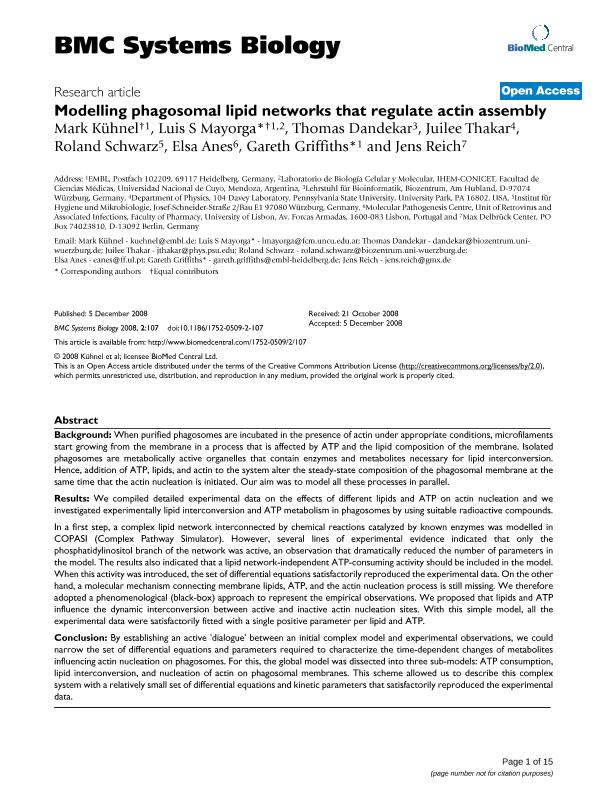Mostrar el registro sencillo del ítem
dc.contributor.author
Kühnel, Marck
dc.contributor.author
Mayorga, Luis Segundo

dc.contributor.author
Dandekar, Thomas
dc.contributor.author
Thakar, Juilee
dc.contributor.author
Schwarz, Roland
dc.contributor.author
Anes, Elsa
dc.contributor.author
Griffiths, Gareth
dc.contributor.author
Reich, Jens
dc.date.available
2021-03-04T20:06:50Z
dc.date.issued
2008-12
dc.identifier.citation
Kühnel, Marck; Mayorga, Luis Segundo; Dandekar, Thomas; Thakar, Juilee; Schwarz, Roland; et al.; Modelling phagosomal lipid networks that regulate actin assembly; BioMed Central; Bmc Systems Biology; 2; 12-2008; 107-108
dc.identifier.issn
1752-0509
dc.identifier.uri
http://hdl.handle.net/11336/127528
dc.description.abstract
Background: When purified phagosomes are incubated in the presence of actin under appropriate conditions, microfilaments start growing from the membrane in a process that is affected by ATP and the lipid composition of the membrane. Isolated phagosomes are metabolically active organelles that contain enzymes and metabolites necessary for lipid interconversion. Hence, addition of ATP, lipids, and actin to the system alter the steady-state composition of the phagosomal membrane at the same time that the actin nucleation is initiated. Our aim was to model all these processes in parallel. Results: We compiled detailed experimental data on the effects of different lipids and ATP on actin nucleation and we investigated experimentally lipid interconversion and ATP metabolism in phagosomes by using suitable radioactive compounds. In a first step, a complex lipid network interconnected by chemical reactions catalyzed by known enzymes was modelled in COPASI (Complex Pathway Simulator). However, several lines of experimental evidence indicated that only the phosphatidylinositol branch of the network was active, an observation that dramatically reduced the number of parameters in the model. The results also indicated that a lipid network-independent ATP-consuming activity should be included in the model. When this activity was introduced, the set of differential equations satisfactorily reproduced the experimental data. On the other hand, a molecular mechanism connecting membrane lipids, ATP, and the actin nucleation process is still missing. We therefore adopted a phenomenological (black-box) approach to represent the empirical observations. We proposed that lipids and ATP influence the dynamic interconversion between active and inactive actin nucleation sites. With this simple model, all the experimental data were satisfactorily fitted with a single positive parameter per lipid and ATP. Conclusion: By establishing an active 'dialogue' between an initial complex model and experimental observations, we could narrow the set of differential equations and parameters required to characterize the time-dependent changes of metabolites influencing actin nucleation on phagosomes. For this, the global model was dissected into three sub-models: ATP consumption, lipid interconversion, and nucleation of actin on phagosomal membranes. This scheme allowed us to describe this complex system with a relatively small set of differential equations and kinetic parameters that satisfactorily reproduced the experimental data.
dc.format
application/pdf
dc.language.iso
eng
dc.publisher
BioMed Central

dc.rights
info:eu-repo/semantics/openAccess
dc.rights.uri
https://creativecommons.org/licenses/by/2.5/ar/
dc.subject
MATHEMATICAL MODEL
dc.subject
PHAGOSOME
dc.subject
MEMBRANE LIPIDS
dc.subject
PHOSPHOLIPIDS
dc.subject.classification
Biología Celular, Microbiología

dc.subject.classification
Ciencias Biológicas

dc.subject.classification
CIENCIAS NATURALES Y EXACTAS

dc.title
Modelling phagosomal lipid networks that regulate actin assembly
dc.type
info:eu-repo/semantics/article
dc.type
info:ar-repo/semantics/artículo
dc.type
info:eu-repo/semantics/publishedVersion
dc.date.updated
2020-08-04T19:40:43Z
dc.journal.volume
2
dc.journal.pagination
107-108
dc.journal.pais
Reino Unido

dc.journal.ciudad
Londres
dc.description.fil
Fil: Kühnel, Marck. European Molecular Biology Laboratory; Alemania
dc.description.fil
Fil: Mayorga, Luis Segundo. Consejo Nacional de Investigaciones Científicas y Técnicas. Centro Científico Tecnológico Conicet - Mendoza. Instituto de Histología y Embriología de Mendoza Dr. Mario H. Burgos. Universidad Nacional de Cuyo. Facultad de Ciencias Médicas. Instituto de Histología y Embriología de Mendoza Dr. Mario H. Burgos; Argentina. European Molecular Biology Laboratory; Alemania
dc.description.fil
Fil: Dandekar, Thomas. Universität Würzburg; Alemania
dc.description.fil
Fil: Thakar, Juilee. State University of Pennsylvania; Estados Unidos
dc.description.fil
Fil: Schwarz, Roland. Universität Würzburg; Alemania
dc.description.fil
Fil: Anes, Elsa. Universidad de Lisboa; Portugal
dc.description.fil
Fil: Griffiths, Gareth. Consejo Nacional de Investigaciones Científicas y Técnicas. Centro Científico Tecnológico Conicet - Mendoza. Instituto de Histología y Embriología de Mendoza Dr. Mario H. Burgos. Universidad Nacional de Cuyo. Facultad de Ciencias Médicas. Instituto de Histología y Embriología de Mendoza Dr. Mario H. Burgos; Argentina. European Molecular Biology Laboratory; Alemania
dc.description.fil
Fil: Reich, Jens. Max-Delbrück-Centrum für Molekulare Medizin; Alemania
dc.journal.title
Bmc Systems Biology

dc.relation.alternativeid
info:eu-repo/semantics/altIdentifier/url/https://bmcsystbiol.biomedcentral.com/articles/10.1186/1752-0509-2-107
dc.relation.alternativeid
info:eu-repo/semantics/altIdentifier/doi/http://dx.doi.org/10.1186/1752-0509-2-107
Archivos asociados
